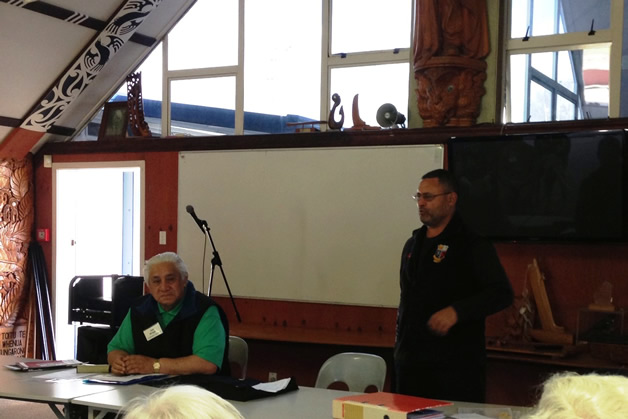Ngāi Tahu ki Tauranga Moana
Voyaging enthusiast Jack Thatcher was guest speaker at the Ngāi Tahu ki Tauranga Moana bimonthly meeting in August. His kōrero about his ocean voyaging adventures was a great success despite the fact that the digital gear he was hoping to use illustrate his kōrero wasn’t working. His presentation style and the word pictures he painted more than made up for that.
The well-attended meeting was chaired by Uncle Joe Briggs and Jack spoke mostly about the haerenga ki Rapanui, the journey undertaken as a celebration of Hector Busby’s achievements and his desire to complete “the Polynesian triangle”.
Getting the waka, Te Aurere and Ngahiraka-mai-tawhiti, on the ocean was a huge logistical challenge. The project was close to 15 years in the planning stage and was bedevilled by funding worries and crew-training concerns. Planning the voyage route was also complex as stops had to be attainable so that provisioning and crew rotation requirements could be met.
Voyages of more than 30 days between landfall are a particular challenge and Jack reported that their first leg took them 43 often stormy days. As the journey unfolded, the day-to-day responsibility of running the waka and the sleeplessness on stormy nights, created some crew tension. On the plus side, in good weather, Jack said a trainee navigator, sitting a sea trial test and using traditional, star-based navigational techniques, managed to bring the waka safely to a dot of an island. Not only that, the trainee managed to closely mimic the course that modern technology had recommended.
With the renaissance of voyaging much of the traditional knowledge thought to have been lost has been regained and interest in old ways is spreading. In the process friendships and whakapapa links have been renewed amongst the peoples of the Pacific. At the same time, a number of myths – that waka were never capable of the feats of planned exploration claimed – have been disproven. Ancient kōrero has it that Ui-te-Rangiora explored far enough to the cold south to see rocks (of ice) sticking up out of the water.
I’ve always wondered why so many of the mōkai –the huge rock statues of ancestors found on Rapanui – are no longer standing. But I never wondered why the mōkai were without eyes. Neither did I understand the two things were connected. The eyes (made of coral) represented the soul of the ancestor. During a period of island strife, the mōkai were robbed of their eyes, most being pushed over to aid the robbery. That the people of Rapanui obtained some of the remaining eyes, held by the Chilean authorities, to show the visitors, and moreover – against the wishes of those authorities – placed them back into upright mōkai, showed something of the importance of waka visit.
Jack summed up his passion for voyaging with these words: “We want to know what it was like for our tīpuna and the only way we can do that, is to do it the way they did it. We want to keep doing it so we don’t lose it; we want to keep the knowledge alive. We are out there doing it for ourselves and there is no need to prove things.”
I echo Uncle Joe’s recommendation that a book be made of these voyages. Until that time check out the Waka Tapu website: http://www.wakatapu.com/ Nā Laurie Loper.

Jack Thatcher, right, speaking to our rōpū about his Waka Tapu voyage to Rapanui. Uncle Joe Briggs sits on the left.